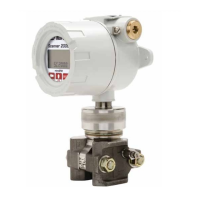44
Section 2 Scanner
®
2000 microEFM
CAUTION When measuring steam, process connections must be designed to eliminate air pock-
ets. This is achieved by making sure all tubing in the cold legs slopes upward. A side-
port MVT and block manifold (shown in Figure 2.9) is recommended to help prevent air
bubbles from being trapped in the sensor.
If a bottom-port MVT is used, the bottom process ports must be plugged or replaced with
a drain valve, and side vents must be used for process connections. A block manifold is
not recommended for use with bottom port MVTs. Contact a Cameron eld representative
for assistance.
1. Verify that the meter is properly installed in the ow line (per manufacturer’s instructions).
2. Mount the Scanner 2000 to a 2-in. pipe or to a at, vertical surface using bolts and the mounting holes in
the enclosure. A horizontal pipe is recommended, as additional hardware may be required for a vertical
pipe mount to provide clearance for the manifold block.
3. Mount a set of pipe tees (which serve as condensate pots) typically on either side of the Scanner 2000 at an
elevation above the process connections of the Scanner 2000 MVT (for proper drainage). They should be a
considerable distance (4 ft) from the sensor ports, but as close as possible to the pressure taps on the meter.
4. Install a pipe cap or a blowdown valve that is rated for steam service at the top of each pipe tee. A blow-
down valve is recommended when the steam passing through the meter is known to be dirty.
5. Install tubing and ttings to connect the high-pressure and low-pressure taps of the DP meter to the pipe
tees. This section is typically referred to as the hot legs of the installation, as this section of tubing en-
counters steam at its highest temperature. Install a shut-off valve near the high and low ports of the DP
meter. Use a suitable compound or tape on all threaded process connections.
6. Route any additional inputs/outputs or COM connections, etc. through the conduit opening in the top of
the Scanner 2000. For hazardous areas, review Hazardous Area Installations, page 27.
Note: To prevent ttings from turning and/or to avoid putting tension on stainless steel tubing, use a backup
wrench to attach stainless steel tubing to shut-off valves, or sensor ports.
CAUTION Whenever possible, locate the hot legs of a steam installation behind the Scanner 2000
safely out of the operator’s normal reach. This will help prevent accidental burns.
7. Install tubing to connect the high-pressure and low-pressure process connections of the block manifold to
the pipe tees installed in step 3. This tubing section is typically referred to as the cold legs of the installa-
tion, since it is lled with water.
8. To eliminate air bubbles, ll the cold legs with water or other ll uid from the lowest point in the system,
typically the MVT, using the following steps:
a. Open the blowdown valve or remove the lling plug from one of the pipe tees/condensate pots.
b. Open the equalizer and bypass/block valves on the block manifold. Make sure the vent valve is
closed.
c. Remove the corresponding (high pressure or low pressure) vent screw from the side of the MVT and
insert a tting to allow connection of a hand pump or funnel. If a funnel is used, attach a length of
Tygon tubing that is long enough to elevate the funnel well above the condensate pot to force the uid
up the legs.

